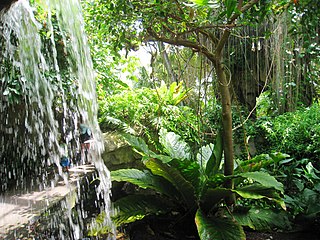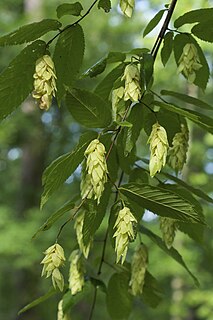
A cloud forest, also called a water forest, primas forest, or tropical montane cloud forest (TMCF), is a generally tropical or subtropical, evergreen, montane, moist forest characterized by a persistent, frequent or seasonal low-level cloud cover, usually at the canopy level, formally described in the International Cloud Atlas (2017) as silvagenitus. Cloud forests often exhibit an abundance of mosses covering the ground and vegetation, in which case they are also referred to as mossy forests. Mossy forests usually develop on the saddles of mountains, where moisture introduced by settling clouds is more effectively retained.

Pleurothallis is a genus of orchids commonly called bonnet orchids. The genus name is derived from the Greek word pleurothallos, meaning "riblike branches". This refers to the rib-like stems of many species. The genus is often abbreviated as "Pths" in horticultural trade.

The Cleveland Botanical Garden, located in the University Circle neighborhood of Cleveland, Ohio, in the United States.

The San Francisco Botanical Garden at Strybing Arboretum is located in San Francisco's Golden Gate Park. Its 55 acres represents nearly 9,000 different kinds of plants from around the world, with particular focus on Magnolia species, high elevation palms, conifers, and cloud forest species from Central America, South America and Southeast Asia.

Cibotium, also known as manfern, is a genus of 11 species of tropical tree ferns. It is the only genus in family Cibotiaceae in the Pteridophyte Phylogeny Group classification of 2016. Alternatively, the family may be treated as the subfamily Cibotioideae of a very broadly defined family Cyatheaceae, the family placement used for the genus in Plants of the World Online as of November 2019.

Eucryphia is a small genus of trees and large shrubs native to the south temperate regions of South America and coastal eastern Australia, mainly Tasmania. Sometimes placed in a family of their own, the Eucryphiaceae, more recent classifications place them in the Cunoniaceae. There are seven species, two in South America and five in Australia, and several named hybrids.

Ticodendron incognitum is the only species of Ticodendron, and the only member of the family Ticodendraceae. It is most closely related to the family Betulaceae.

Staphylea, called bladdernuts, is a small genus of 10 or 11 species of flowering plants in the family Staphyleaceae, native to temperate regions of the Northern Hemisphere. The highest species diversity is in China, where four species occur.

Hidalgoa is a genus in the tribe Coreopsideae of the family Asteraceae.

Elmer Drew Merrill was an American botanist and taxonomist. He spent more than twenty years in the Philippines where he became a recognized authority on the flora of the Asia-Pacific region. Through the course of his career he authored nearly 500 publications, described approximately 3,000 new plant species, and amassed over one million herbarium specimens. In addition to his scientific work he was an accomplished administrator, college dean, university professor and editor of scientific journals.

Ostrya virginiana, the American hophornbeam, is a species of Ostrya native to eastern North America, from Nova Scotia west to southern Manitoba and eastern Wyoming, southeast to northern Florida and southwest to eastern Texas. Populations from Mexico and Central America are also regarded as the same species, although some authors prefer to separate them as a distinct species, Ostrya guatemalensis. Other names include eastern hophornbeam, hardhack, ironwood, and leverwood.

Vitis bryoniifolia is a prolific and adaptable, polygamo-dioecious species of climbing vine in the grape family native to China, where it is known as ying yu, or hua bei pu tao. The variant form ternata is known as san chu ying yu, meaning three-foliolate, or -leaflet ying yu. Ying yu translates to mean "hard jade".

The Field Elm cultivar Ulmus minor 'Suberosa', commonly known as the Cork-barked elm, is a slow-growing or dwarf form of conspicuously suberose Field Elm. Of disputed status, it is considered a distinct variety by some botanists, among them Henry (1913), Krüssmann (1984), and Bean (1988), and is sometimes cloned and planted as a cultivar. Henry said the tree "appears to be a common variety in the forests of central Europe", Bean noting that it "occurs in dry habitats". By the proposed rule that known or suspected clones of U. minor, once cultivated and named, should be treated as cultivars, the tree would be designated U. minor 'Suberosa'. The Späth nursery of Berlin distributed an U. campestris suberosa alataKirchn. [:'corky-winged'] from the 1890s to the 1930s.

Lamanonia is a genus of trees in the family Cunoniaceae. It is endemic to South America.

Oxypolis is a small genus of North American flowering plants in the carrot family known as cowbane, water dropwort, dropwort, hog-fennel, and pig-potato. As of 2020, Kew's Plants of the World Online accepts four species in the genus Oxypolis:
Thinouia is a genus of flowering plants belonging to the family Sapindaceae. It is also in the Sapindoideae subfamily and Paullinieae tribe.
Rufodorsia is a genus of epiphytic flowering plants in the family Gesneriaceae. The genus name refers to the reddish back of the upper lobes of the flower. The relationship of Rufodorsia with the genus Oerstedina is uncertain, as of April 2021. It is native to montane cloud forest in Central America.

Potentilla aurea, the golden cinquefoil, is a species of flowering plant in the family Rosaceae. It is native to the mountains of mainland Europe, and has been introduced to Turkey. A number of cultivars are available, including 'Aurantiaca', 'Goldklumpen', and 'Plena'.

Waldsteinia ternata, commonly referred to as barren strawberry, is an herbaceous perennial plant. It has a disjunct distribution, being native to Eastern Europe and Eastern Asia, namely the Changbai Mountains of China, Sakhalin and Siberia in Russia, and Japan.

















